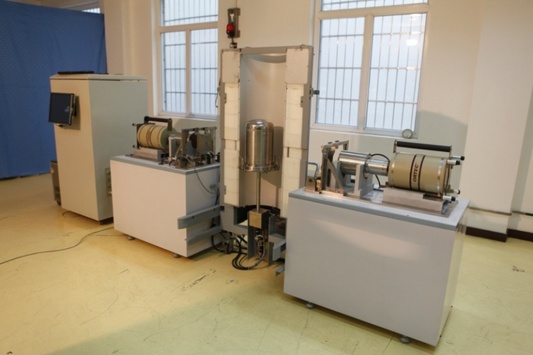 This issue of Science & Global Security contains three important articles on the topics of nuclear warheads, uranium enrichment capacity and the development of a new long-range delivery system.
This issue of Science & Global Security contains three important articles on the topics of nuclear warheads, uranium enrichment capacity and the development of a new long-range delivery system.
In "Nuclear Warhead Verification: A Review of Attribute and Template Systems," (free PDF) Jie Yan and Alexander Glaser from Princeton University look at the several decade long effort to develop means to confirm the authenticity of nuclear warheads for arms control treaty purposes. These efforts have focused in particular on systems to detect and characterize the fissile material (plutonium and highly enriched uranium) components of these warheads. This is an issue that was discussed in this journal in its very first issue in 1989 in an article by Theodore Taylor. Looking at the work done on this issue over the past 25 years, Yan and Glaser describe the different intrinsic characteristics of nuclear weapons and their components selected by the United States and by Russia as a basis for authentication instruments, as well as the attribute set that was agreed as part of the United Kingdom-Norway collaboration. The article also provides information on the six criteria chosen for authenticating a nuclear warhead plutonium-component for the Attributes and Measurement System with Information Barrier built by the Institute of Nuclear Physics and Chemistry at the China Academy of Engineering Physics.
As a step forward in coordinating these efforts, the authors propose a network of laboratories from nuclear weapon states and non-nuclear weapon states be established as soon as possible to work on arms control verification. As a research and policy agenda, they suggest: development of a Universal Test Object to enable the design and testing of warhead inspection systems and to set performance targets; collaboration to identify a set of Agreed Minimal Attributes for nuclear warheads and components for authentication purposes; and, joint design of an information barrier to strip out any weapon design information recorded by instruments in nuclear warhead verification systems to make sure such information is not inadvertently revealed to inspectors.
The second article in this issue is "China's Uranium Enrichment Complex," by Hui Zhang from Harvard University. It offers a significant new assessment of uranium enrichment capacity in China, based on recently published Chinese sources and information from officials at the China National Nuclear Corporation, which manages the enrichment plants, and from commercial satellite images of these plants. The new estimates are much larger than previous public estimates of China's total enrichment capacity.
The article finds China has a total of 10 operating enrichment facilities at four sites. The currently operating eight civilian centrifuge enrichment plants have a combined capacity estimated to be about 4.5 million SWU, with an additional 2 million SWU capacity estimated to be under construction. The centrifuges are suggested to be Russian supplied 6th, 7th and 8th generation machines and Chinese machines based on adaptations of the Russian 6th generation design. Yet more capacity will be needed to reach the estimated 9 million SWU that will be required by 2020 if China is to produce enough enriched uranium domestically to fuel its planned nuclear power reactor fleet.
The article also looks at China's enrichment capacity for non-weapon military uses, which could include enriching uranium for naval fuel and for tritium production. This capacity is estimated to be about 0.3-0.4 million SWU at the old Heping Gaseous Diffusion Plant, which may or may not have been converted to centrifuge technology, and another 0.25 million SWU at the smallest of the three Emeishan centrifuge plants. These may both be dual-use facilities. China is not believed to be producing highly enriched uranium, for weapons or other purposes, with production having ended in about 1987. This has not been formally announced, however.
The third article in this issue is "Hypersonic Boost-Glide Weapons" by James Acton from the Carnegie Endowment for International Peace in Washington, DC. This article the first significant technical analysis of a new type of maneuvering re-entry vehicle under development by the United States, China and Russia, intended to be able to glide thousands of kilometers at hypersonic speeds (greater than Mach 5) and so defeat advanced air and missile defenses, and capable of carrying either nuclear or conventional weapons.
The article presents a simple mathematical model for modeling the many thousands of kilometers long hypersonic trajectory of a boost-glide weapon after it begins to reenter the atmosphere, based on the capabilities of the United States Hypersonic Technology Vehicle-2, which was tested in 2010 and 2011. An online supplement estimates the tactical warning time that a target state might receive about an incoming boost-glide attack depending on whether it had an early warning satellite system, missile early warning radar, or only air defense radar. It also assesses the vulnerability both of hard and deeply buried targets, including silos, as well as dispersed mobile missiles to attack from a conventionally armed boost-glide vehicle and concludes that such a weapon may not offer a decisive new military capability.
The final article in this issue "Research Note to Hypersonic Boost-Glide Weapons by James M. Acton: Analysis of the Boost Phase of the HTV-2 Hypersonic Glider Tests," by David Wright from the Union of Concerned Scientists models the flight from launch through reentry - the boost-glide vehicle launcher was the Minotaur 4-Lite, which is based on the first three stages of the U.S. Peacekeeper intercontinental ballistic missile
